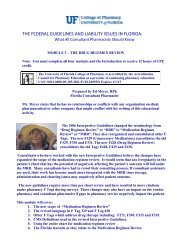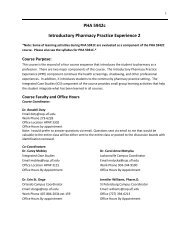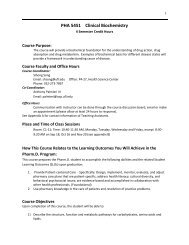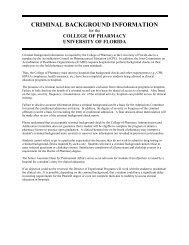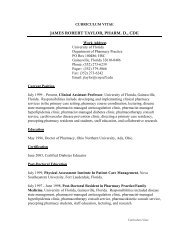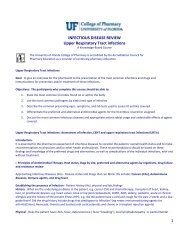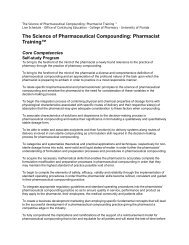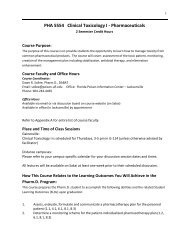Drug Classifications
Drug Classifications
Drug Classifications
Create successful ePaper yourself
Turn your PDF publications into a flip-book with our unique Google optimized e-Paper software.
25<br />
Cardiovascular Agents<br />
Vasopressors- act to increase blood pressure. If a patient is in a<br />
state of shock due to decreased blood volume, inadequate cardiac<br />
output or severe infection, fluids may be introduced to provide<br />
adequate blood volume. In addition to fluid replacement,<br />
vasopressors may be used to help supply blood to the brain and<br />
kidney.<br />
Antihyperlipidemics- used to lower high levels of cholesterol that<br />
can lead top blocked blood vessels. Cholesterol is a lipid normally<br />
present in the body that is essential for healthy cell function.<br />
Cholesterol levels are measured as total cholesterol, LDL (low density<br />
lipoprotein), and HDL (high density lipoprotein). Excessive amounts of<br />
LDL can lead to blocked blood vessels and cardiovascular problems.<br />
HMG-CoA Reductase inhibitors(“statins”) are used to treat high LDL<br />
levels.<br />
26<br />
Cardiovascular Agents<br />
Thrombolytics/Anticoagulants- thrombolytics are used to dissolve<br />
blood clots and anticoagulants are used to prevent their formation.<br />
Thrombolytics can be dangerous since blood clotting can be<br />
disturbed, resulting in profuse bleeding and even fatal bleeding.<br />
However, in cases of impending myocardial infarction or stroke, a<br />
traveling blood clot (embolus) can be dissolved and the stroke<br />
prevented. There has been much success with this group of drugs in<br />
recent years. A common thrombolytic agent is alteplase. Common<br />
anticoagulants are warfarin and heparin.<br />
Dermatologicals<br />
Dermatologicals are used to treat a condition or disease<br />
related to the skin.<br />
Skin is the largest organ and protects the other organs against<br />
microorganisms, trauma, extreme temperature, and other<br />
harmful elements.<br />
Common dermatological agents include steroids,<br />
antihistamines and anti-infectives.<br />
Examples: hydrocortisone cream, diphenhydramine, silver<br />
sulfadiazine cream, doxycycline hyclate, and ofloxacin.<br />
The drying agent zinc oxide is often seen in a combination<br />
product with the local anesthetic camphor, moisture absorbing<br />
agent kaolin, and an anti-infective such as triclosan when<br />
treating diaper rash.<br />
27<br />
9



